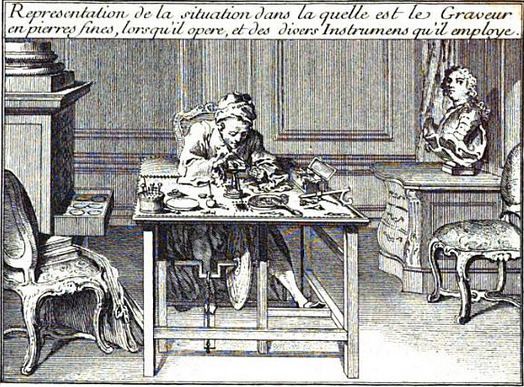Nationality French Name Jacques Guay | Occupation Gemstone engraver | |
 | ||
Died 1787 (aged 71–72)Paris, France | ||
Jacques Guay (c. 1715–1787) was a French gemstone engraver, a protege of Madame de Pompadour (1721–1764), the mistress of King Louis XV of France (1710–1774). He was the most eminent gemstone engraver of his time, the official engraver of the king, and produced many cameo and intaglio engravings in semi-precious stones such as onyx, jasper and carnelian. Subjects included classical figures, events in the reign of the king and portraits of members of the court.
Contents
Early years
Jacques Guay was born in Marseille around 1715. Little is known about his family or early life. He came to Paris at an early age and studied drawing with Francois Boucher. He met the rich financier and collector Pierre Crozat and studied his collection of 1,400 classical engraved gemstones. He decided to study the art of fine stone engraving. His first efforts were successful, but he needed formal training. He went to Florence in 1742, where he studied the antique stones in the grand duke's collection. He went on to Rome, where King Louis XV of France let him stay in the French Academy's building, and saw the best collections of classical antiques in Rome. He made several engraved stones while in Rome.
Career
After Guay returned to France the king's mistress Jeanne-Antoinette Poisson, Madame de Pompadour, an artist in her own right, installed him in her apartment in the Palace of Versailles and charged him with making engravings in gemstones of the main events and characters of the reign. Guay made an engraving on a small carnelian of the Triumph of Fontenoy after a design provided by Edme Bouchardon. This was the first of a series of engravings on historical subjects.
Guay was named graveur du roi (king's engraver) in 1745, and was granted lodgings in the Louvre. He succeeded Francois-Julien Barier (1680–1746) in this position. Barier, who had a minutely detailed style, was much inferior as an artist. Guay was agree for admission to the Academie royale de peinture et de sculpture in 1747, the first gemstone engraver to receive this honor. He was formally admitted on 30 March 1748. He exhibited his work at almost all the Salons from 1747 to 1759. He taught Madame de Pompadour how to engrave stones, and she acquired proficiency as shown in surviving samples of her work in onyx, jasper and other precious stones. One of her works was of Victory, a self-portrait in sardonyx, which she had made up into a bracelet.
In 1753 Guay made a splendid cameo portrait of Louis XV in sardonyx. In a portrait of Madame de Pompadour by Boucher, exhibited in a Salon of 1755, papers at her feet include one of her print engravings after a cameo by Guay. A portrait of Madame de Pompadour at Her Toilette shows her wearing Guay's cameo of Louis XV on her wrist. Guay's miniature of Louis XV, cut from three-color sardonyx, was the basis for an etching of the king as a Roman emperor by Pompadour. One of the last of Guay's historical works was Wishes for the recovery of the health of Madame de Pompadour. There were two variants, one an intaglio in rock crystal dated 1764, the year of Madame de Pompadour's death. The work is incomplete since it could not be offered to its intended recipient.
Guay lost much of his importance after the death of the marquise. No more historical works by him are known, other than an allegory on the accession of Louis XVI dated 1774. Guay made some portraits for the new court. Jacques Guay died in Paris in 1787, aged about 72. A review of gem engraving published in 1819 said that "France, which at no time excelled in the number of good gem engravers has, ever since Guay's time, been particularly deficient in this class of artists, so that Millin (in 1797) considered the glyptic art as absolutely extinct in his country. There is however, at the present day, a skilful engraver in Paris of the name of Jeoffroy, whom the national institute has thought worthy to receive among its members."
Work
Guay's style is closer to the work of contemporary medalists and Rococo artists such as Boucher and Bouchardon than to the Roman masters of gem engraving. A record of Guay's work has been preserved in a collection of ink engravings by the marquise de Pompadour, reproducing Guay's stone engravings, and in drawings made as guides for his work by Guay himself, Boucher and Joseph-Marie Vien (1716–1809). The Pompadour collection includes fifty-two plates plus a frontispiece. Each plate is accompanied by a description of the subject represented. The prints were bound into a handsome volume that was given to favored members of the court. The collection includes eight intaglio copies of classical works made in Rome, mostly unsigned:
Guay's engravings of historical subjects include:
In addition Guay made various portraits of members of the court, notably his famous cameo of Louis XV.
